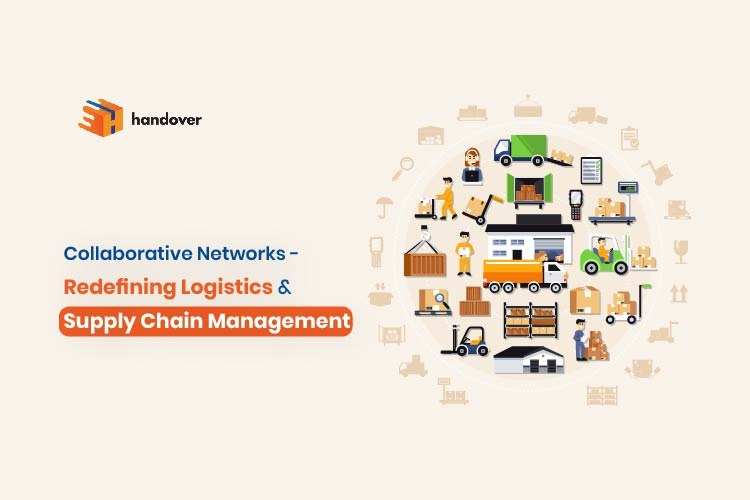Handover news
Blog
Collaborative Networks – Redefining Logistics and Supply Chain Management

India’s supply chain landscape is as extensive and varied as its rich cultural legacy. The country’s population size of 1.4 billion often makes the flow of products complicated. Collaborative logistics networks have, however, been a game-changer by making India’s intricate supply chain ecosystem more efficient and futuristic.
The foundation of collaborative logistics networks is based on shared resources, coordination and cooperation. They work together to build an efficient and well-coordinated supply chain network including manufacturers, suppliers, distributors, and retailers, etc. By cooperating and utilising innovative technologies, these networks allow parties to function together, optimising effectiveness and reducing expenses.
Why is Supply Chain Collaboration Important?
During the last several decades, decentralisation was required to maintain operations as corporations grew to include extensive supply and demand networks. Such vast systems could not be managed by a centralised staff due to the limits of the supply chain technology available at the time.
Rather, a lot of businesses divide their operations across semi-autonomous regional offices and distribution hubs, which can arrange, carry out, and manage freight movement. These systems, while robust and effective, were also highly inefficient because they relied on teams who had to do the same tasks almost simultaneously.
Advanced supply chain visibility solutions, which focus on improved planning, visibility, communications and more, have become more prevalent. Teams can now carry out the same responsibilities from a single control tower. This, in turn, allows for more effective collaboration among departments and internal organisations, as well as with the greater supply chain collaboration network of partners, suppliers and customers.
How to Improve Supply Chain Collaboration?
Ineffective communication is one of the biggest obstacles to successful supply chain collaboration. Due to the logistics industry’s lengthy history of decentralisation, many firms have created proprietary workflows, methods, and systems that are very hard to understand by people outside of their department or organisation. In order to address this, businesses need to put in place specialised, shared systems that allow them to effectively communicate with partners, external stakeholders, and the supply chain network.
For any supply chain collaboration to be successful, data is also essential. Robust data is the cornerstone of strong decision-making for organisations of all shapes. It promotes effective performance throughout entire organisations as well as between team members individually.
Overcoming barriers to effective collaboration requires a sustained effort on your supply chain management. There are no shortcuts to successful supply chain collaboration. However, the following recommendations represent a strong first step to reaping the benefits of improved collaboration for your business.
The following are the benefits of successful supply chain collaboration for your business.
Identify Opportunities
You already work closely with suppliers, customers, partners in transportation, and vendors. Discovering new ways to accomplish this more effectively can optimise operational expenses, customer satisfaction and efficiency. Consider each partner as a chance to enhance your supply chain cooperation projects.
Break Down Data Silos
Many efforts at supply chain collaboration visibility are plagued by siloed data, incompatible technology, and incomplete documents and informal processes. The first step in resolving this is to centralise the data into a single system that team members from around the organisation can access. This eliminates cross-functional dependencies and technical incompatibilities, enabling all internal stakeholders to work more independently and effectively.
Look to Include Those Outside Your Supply Chain Collaboration Network
It is not necessary for two companies’ supply chains to overlap just because they are in competition with each other. In fact, there are several benefits to collaborative logistics among businesses in the same industry. For example, lowering dwell time can increase available capacity across the industry.
Use Tools That Help in Supply Chain Visibility and Collaboration
Innovative technologies, such as GPS tracking, IoT devices and cloud-based platforms ensure real-time tracking, predictive analytics and data-driven insights. All that leads to enhanced efficiency and accuracy of supply chain management.
Conclusion
Collaborative logistics networks have lots of potential to revolutionise India’s supply chain landscape. They can foster cooperation, streamline operations and reduce costs. These networks help businesses boost their efficiency and drive sustainable growth. As India’s economy is continuously growing, embracing collaborative logistics networks becomes crucial for building a resilient and competitive supply chain ecosystem. If you are looking for a logistics service company, handover (handover Karo, Khush Raho), a pioneer logistics services provider with impressive delivery services in Noida, Ghaziabad Delhi, Mumbai, Pune, Bangalore, and several other cities across India.
